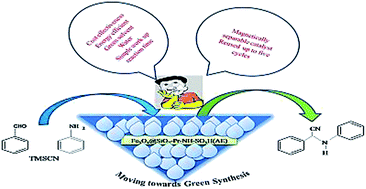The surface modification of SiO2 coated Fe3O4 nanoparticles by grafting silane coupling agents is a highly significant approach to enhancing the interface interaction between the inorganic magnetic core and the organic functionality to be anchored. However, the effect of the grafted molecular structure of silane, utilizing different silane alkoxy groups, has been seldom investigated on the organic–inorganic hybrid magnetic heterogeneous catalysts. The silanization was carried out on the surface of SiO2 coated Fe3O4 nanoparticles using two different trialkoxy silanes, i.e., 3-aminopropyltriethoxysilane (APTES) and 3-aminopropyltrimethoxysilane (APMES). The effect of the alkoxy silane structure anchored to the surface of silica functionalized Fe3O4 nanoparticles on their surface area and pore volume has been analyzed by BET analyzer. The silane functionalization using APTES leads to higher surface area and pore volume than APTMS. Further, chlorosulphonic acid was immobilized on both the APTES and APTMS functionalized SiO2@Fe3O4 nanoparticles named (AE and AM), and their role as magnetically separable heterogeneous catalyst for the one pot synthesis of α-aminonitriles using water as solvent was successfully carried out. The chlorofunctionalized nanoparticles, which utilized APTES as the silanizing agent, showed better catalytic activity than APTMS in terms of reaction time and yield. The presented protocol is a water based synthesis involving room temperature conditions, along with reusability and recyclability of the catalyst. The characterization of the synthesized catalysts was carried out by using different techniques, such as FT-IR, XRD, TEM, BET, XPS, VSM and TGA-DTA.
